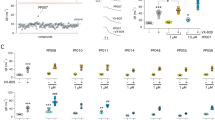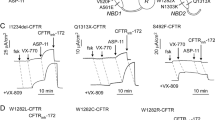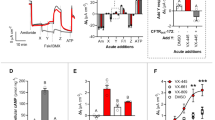Abstract
Available corrector drugs are unable to effectively rescue the folding defects of CFTR-ΔF508 (or CFTR-F508del), the most common disease-causing mutation of the cystic fibrosis transmembrane conductance regulator, a plasma membrane (PM) anion channel, and thus to substantially ameliorate clinical phenotypes of cystic fibrosis (CF). To overcome the corrector efficacy ceiling, here we show that compounds targeting distinct structural defects of CFTR can synergistically rescue mutant expression and function at the PM. High-throughput cell-based screens and mechanistic analysis identified three small-molecule series that target defects at nucleotide-binding domain (NBD1), NBD2 and their membrane-spanning domain (MSD) interfaces. Although individually these compounds marginally improve ΔF508-CFTR folding efficiency, function and stability, their combinations lead to ~50–100% of wild-type-level correction in immortalized and primary human airway epithelia and in mouse nasal epithelia. Likewise, corrector combinations were effective against rare missense mutations in various CFTR domains, probably acting via structural allostery, suggesting a mechanistic framework for their broad application.
This is a preview of subscription content, access via your institution
Access options
Access Nature and 54 other Nature Portfolio journals
Get Nature+, our best-value online-access subscription
$29.99 / 30 days
cancel any time
Subscribe to this journal
Receive 12 print issues and online access
$209.00 per year
only $17.42 per issue
Buy this article
- Purchase on Springer Link
- Instant access to full article PDF
Prices may be subject to local taxes which are calculated during checkout






Similar content being viewed by others

Data availability
The datasets generated during and/or analyzed during the current study are available from the corresponding author on reasonable request.
References
Veit, G. et al. From CFTR biology toward combinatorial pharmacotherapy: expanded classification of cystic fibrosis mutations. Mol. Biol. Cell 27, 424–433 (2016).
Sosnay, P. R. et al. Defining the disease liability of variants in the cystic fibrosis transmembrane conductance regulator gene. Nat. Genet. 45, 1160–1167 (2013).
Cutting, G. R. Cystic fibrosis genetics: from molecular understanding to clinical application. Nat. Rev. Genet. 16, 45–56 (2015).
Liu, F., Zhang, Z., Csanady, L., Gadsby, D. C. & Chen, J. Molecular structure of the human CFTR ion channel. Cell 169, 85–95 e88 (2017).
Hunt, J. F., Wang, C. & Ford, R. C. Cystic fibrosis transmembrane conductance regulator (ABCC7)structure. Cold Spring Harb. Perspect. Med. 3, a009514 (2013).
Hwang, T. C. & Kirk, K. L. The CFTR ion channel: gating, regulation, and anion permeation. Cold Spring Harb. Perspect. Med. 3, a009498 (2013).
Chong, P. A., Kota, P., Dokholyan, N. V. & Forman-Kay, J. D. Dynamics intrinsic to cystic fibrosis transmembrane conductance regulator function and stability. Cold Spring Harb. Perspect. Med. 3, a009522 (2013).
Okiyoneda, T., Apaja, P. M. & Lukacs, G. L. Protein quality control at the plasma membrane. Curr. Opin. Cell Biol. 23, 483–491 (2011).
Rabeh, W. M. et al. Correction of both NBD1 energetics and domain interface is required to restore ΔF508 CFTR folding and function. Cell 148, 150–163 (2012).
Mendoza, J. L. et al. Requirements for efficient correction of ΔF508 CFTR revealed by analyses of evolved sequences. Cell 148, 164–174 (2012).
Farinha, C. M. et al. Revertants, low temperature, and correctors reveal the mechanism of F508del-CFTR rescue by VX-809 and suggest multiple agents for full correction. Chem. Biol. 20, 943–955 (2013).
He, L. et al. Restoration of NBD1 thermal stability is necessary and sufficient to correct ∆F508 CFTR folding and assembly. J. Mol. Biol. 427, 106–120 (2015).
Hall, J. D. et al. Binding screen for cystic fibrosis transmembrane conductance regulator correctors finds new chemical matter and yields insights into cystic fibrosis therapeutic strategy. Protein Sci. 25, 360–373 (2016).
Cui, L. et al. Domain interdependence in the biosynthetic assembly of CFTR. J. Mol. Biol. 365, 981–994 (2007).
Du, K. & Lukacs, G. L. Cooperative assembly and misfolding of CFTR domains in vivo. Mol. Biol. Cell 20, 1903–1915 (2009).
Du, K., Sharma, M. & Lukacs, G. L. The ΔF508 cystic fibrosis mutation impairs domain–domain interactions and arrests post-translational folding of CFTR. Nat. Struct. Mol. Biol. 12, 17–25 (2005).
Okiyoneda, T. et al. Mechanism-based corrector combination restores ΔF508-CFTR folding and function. Nat. Chem. Biol. 9, 444–454 (2013).
Vernon, R. M. et al. Stabilization of a nucleotide-binding domain of the cystic fibrosis transmembrane conductance regulator yields insight into disease-causing mutations. J. Biol. Chem. 292, 14147–14164 (2017).
Phuan, P. W. et al. Synergy-based small-molecule screen using a human lung epithelial cell line yields ΔF508-CFTR correctors that augment VX-809 maximal efficacy. Mol. Pharmacol. 86, 42–51 (2014).
Lopes-Pacheco, M. et al. Combination of correctors rescue ΔF508-CFTR by reducing its association with Hsp40 and Hsp27. J. Biol. Chem. 290, 25636–25645 (2015).
Wang, Y., Loo, T. W., Bartlett, M. C. & Clarke, D. M. Additive effect of multiple pharmacological chaperones on maturation of CFTR processing mutants. Biochem. J. 406, 257–263 (2007).
Taylor-Cousar, J. L. et al. Tezacaftor–ivacaftor in patients with cystic fibrosis homozygous for Phe508del. N. Engl. J. Med. 377, 2013–2023 (2017).
Van Goor, F. et al. Correction of the F508del-CFTR protein processing defect in vitro by the investigational drug VX-809. Proc. Natl. Acad. Sci. USA 108, 18843–18848 (2011).
Ren, H. Y. et al. VX-809 corrects folding defects in cystic fibrosis transmembrane conductance regulator protein through action on membrane-spanning domain 1. Mol. Biol. Cell 24, 3016–3024 (2013).
Wainwright, C. E. et al. Lumacaftor–ivacaftor in patients with cystic fibrosis homozygous for Phe508del CFTR. N. Engl. J. Med. 373, 220–231 (2015).
Veit, G. et al. Some gating potentiators, including VX-770, diminish ΔF508-CFTR functional expression. Sci. Transl. Med. 6, 246ra97 (2014).
Cholon, D. M. et al. Potentiator ivacaftor abrogates pharmacological correction of ΔF508 CFTR in cystic fibrosis. Sci. Transl. Med. 6, 246ra96 (2014).
Ehrhardt, C. et al. Towards an in vitro model of cystic fibrosis small airway epithelium: characterisation of the human bronchial epithelial cell line CFBE41o-. Cell Tissue Res. 323, 405–415 (2006).
Thibodeau, P. H. et al. The cystic fibrosis–causing mutation ΔF508 affects multiple steps in cystic fibrosis transmembrane conductance regulator biogenesis. J. Biol. Chem. 285, 35825–35835 (2010).
Pedemonte, N. et al. Small-molecule correctors of defective ΔF508-CFTR cellular processing identified by high-throughput screening. J. Clin. Invest. 115, 2564–2571 (2005).
Pissarra, L. S. et al. Solubilizing mutations used to crystallize one CFTR domain attenuate the trafficking and channel defects caused by the major cystic fibrosis mutation. Chem. Biol. 15, 62–69 (2008).
Apaja, P. M., Xu, H. & Lukacs, G. L. Quality control for unfolded proteins at the plasma membrane. J. Cell Biol. 191, 553–570 (2010).
Duarri, A. et al. Molecular pathogenesis of megalencephalic leukoencephalopathy with subcortical cysts: mutations in MLC1 cause folding defects. Hum. Mol. Genet. 17, 3728–3739 (2008).
Takahashi, K. et al. V2 vasopressin receptor (V2R) mutations in partial nephrogenic diabetes insipidus highlight protean agonism of V2R antagonists. J. Biol. Chem. 287, 2099–2106 (2012).
Apaja, P. M. et al. Ubiquitination-dependent quality control of hERG K+channel with acquired and inherited conformational defect at the plasma membrane. Mol. Biol. Cell 24, 3787–3804 (2013).
Zhang, F., Kartner, N. & Lukacs, G. L. Limited proteolysis as a probe for arrested conformational maturation of ΔF508 CFTR. Nat. Struct. Biol. 5, 180–183 (1998).
Hegedus, T. et al. F508del CFTR with two altered RXR motifs escapes from ER quality control but its channel activity is thermally sensitive. Biochim. Biophys. Acta 1758, 565–572 (2006).
Bagdany, M. et al. Chaperones rescue the energetic landscape of mutant CFTR at single molecule and in cell. Nat. Commun. 8, 398 (2017).
Veit, G. et al. Ribosomal stalk protein silencing partially corrects the ΔF508-CFTR functional expression defect. PLoS Biol. 14, e1002462 (2016).
Pranke, I. M. et al. Correction of CFTR function in nasal epithelial cells from cystic fibrosis patients predicts improvement of respiratory function by CFTR modulators. Sci. Rep. 7, 7375 (2017).
Liu, X. et al. Conditional reprogramming and long-term expansion of normal and tumor cells from human biospecimens. Nat. Protoc. 12, 439–451 (2017).
Müller, L., Brighton, L. E., Carson, J. L., Fischer, W. A. II & Jaspers, I. Culturing of human nasal epithelial cells at the air liquid interface. J. Vis. Exp. 80, 50646 (2013).
Avramescu, R. G. et al. Mutation-specific downregulation of CFTR2 variants by gating potentiators. Hum. Mol. Genet. 26, 4873–4885 (2017).
Ostedgaard, L. S. et al. Processing and function of CFTR-ΔF508 are species-dependent. Proc. Natl. Acad. Sci. USA 104, 15370–15375 (2007).
French, P. J. et al. A ΔF508 mutation in mouse cystic fibrosis transmembrane conductance regulator results in a temperature-sensitive processing defect in vivo. J. Clin. Invest. 98, 1304–1312 (1996).
da Cunha, M. F. et al. Analysis of nasal potential in murine cystic fibrosis models. Int. J. Biochem. Cell Biol. 80, 87–97 (2016).
Van Goor, F., Yu, H., Burton, B. & Hoffman, B. J. Effect of ivacaftor on CFTR forms with missense mutations associated with defects in protein processing or function. J. Cyst. Fibros. 13, 29–36 (2014).
Robert, R. et al. Correction of the Δ phe508 cystic fibrosis transmembrane conductance regulator trafficking defect by the bioavailable compound glafenine. Mol. Pharmacol. 77, 922–930 (2010).
Coffman, K. C. et al. Constrained bithiazoles: small molecule correctors of defective ΔF508-CFTR protein trafficking. J. Med. Chem. 57, 6729–6738 (2014).
Rowe, S. M. & Verkman, A. S. Cystic fibrosis transmembrane regulator correctors and potentiators. Cold Spring Harb. Perspect. Med. 3, a009761 (2013).
Li, C. & Naren, A. P. CFTR chloride channel in the apical compartments: spatiotemporal coupling to its interacting partners. Integr. Biol. (Camb) 2, 161–177 (2010).
Monterisi, S. et al. CFTR regulation in human airway epithelial cells requires integrity of the actin cytoskeleton and compartmentalized cAMP and PKA activity. J. Cell Sci. 125, 1106–1117 (2012).
Pankow, S. et al. F508 CFTR interactome remodelling promotes rescue of cystic fibrosis. Nature 528, 510–516 (2015).
Trzcińska-Daneluti, A. M. et al. RNA interference screen to identify kinases that suppress rescue of ΔF508-CFTR. Mol. Cell. Proteomics 14, 1569–1583 (2015).
Okiyoneda, T. et al. Peripheral protein quality control removes unfolded CFTR from the plasma membrane. Science 329, 805–810 (2010).
Tosco, A. et al. A novel treatment of cystic fibrosis acting on-target: cysteamine plus epigallocatechin gallate for the autophagy-dependent rescue of class II-mutated CFTR. Cell Death Differ. 23, 1380–1393 (2016).
Roth, D. M. et al. Modulation of the maladaptive stress response to manage diseases of protein folding. PLoS Biol. 12, e1001998 (2014).
Hegde, R. N. et al. Unravelling druggable signalling networks that control F508del-CFTR proteostasis. eLife 4, e10365 (2015).
Calamini, B. et al. Small-molecule proteostasis regulators for protein conformational diseases. Nat. Chem. Biol. 8, 185–196 (2011).
Griesenbach, U., Geddes, D. M. & Alton, E. W. The pathogenic consequences of a single mutated CFTR gene. Thorax 54 (Suppl 2), S19–S23 (1999).
Veit, G. et al. Proinflammatory cytokine secretion is suppressed by TMEM16A or CFTR channel activity in human cystic fibrosis bronchial epithelia. Mol. Biol. Cell 23, 4188–4202 (2012).
Liu, X. et al. ROCK inhibitor and feeder cells induce the conditional reprogramming of epithelial cells. Am. J. Pathol. 180, 599–607 (2012).
Neuberger, T., Burton, B., Clark, H. & Van Goor, F. Use of primary cultures of human bronchial epithelial cells isolated from cystic fibrosis patients for the pre-clinical testing of CFTR modulators. Methods Mol. Biol. 741, 39–54 (2011).
van Doorninck, J. H. et al. A mouse model for the cystic fibrosis delta F508 mutation. EMBO J. 14, 4403–4411 (1995).
Namkung, W., Thiagarajah, J. R., Phuan, P. W. & Verkman, A. S. Inhibition of Ca2+-activated Cl– channels by gallotannins as a possible molecular basis for health benefits of red wine and green tea. FASEB J. 24, 4178–4186 (2010).
Myszka, D. G. Improving biosensor analysis. J. Mol. Recognit. 12, 279–284 (1999).
Aleksandrov, A. A. & Riordan, J. R. Regulation of CFTR ion channel gating by MgATP. FEBS Lett. 431, 97–101 (1998).
Saussereau, E. L. et al. Characterization of nasal potential difference in cftr knockout and F508del-CFTR mice. PLoS One 8, e57317 (2013).
Acknowledgements
The authors are grateful to the individuals who volunteered to participate in this study. We thank D. C. Gruenert for the parental CFBE41o- cell line; W. E. Finkbeiner for supplying HBE cells, J. Riordan and the Cystic Fibrosis Foundation for the 660 antibody, P. Thomas for providing vectors encoding some of the CFTR2 mutants and members of the Cystic Fibrosis Folding Consortium for advice. This work was supported by Vaincre La Mucoviscidose to A.E. and I.S.-G., the Canadian Institutes of Health Research (MOP-142221 to G.L.L. and PJT-153095 to G.V., E.M., and G.L.L.), National Institute of Diabetes & Digestive & Kidney Diseases (5R01DK075302 to G.L.L.) and the Cystic Fibrosis Foundation Therapeutics to G.L.L. as well as Cystic Fibrosis Canada to G.L.L. We acknowledge the Canada Foundation for Innovation for infrastructure support: Bruker UltrafleXtreme MALDI-TOF/TOF system (grant no. 32616, awarded to G. Multhaup and G.L.L.); BIACORE T200 SPR system (grant no. 228340 awarded to G. Multhaup). R.G.A. is a recipient of the Fonds de Recherche du Québec Santé (FRQS) Doctoral Training Scholarship. G.L.L. is a Canada Research Chair.
Author information
Authors and Affiliations
Contributions
The overall design of the study was by G.V., W.G.B. and G.L.L.; G.V., H.X., E.D., R.G.A., M.B., L.K.B., C.L., W.L., K.M., S.G., P.A.M., and E.A. performed experiments and analyzed the results; A.R. cloned and purified the avi-tagged NBD1 variants; M.A.H. performed the SPR studies; S.F. and E.M. collected the patient samples for HNE isolation; A.E. and I.S.-G. designed and directed the mouse studies; A.P.O., P.M. and W.G.B. designed and directed the HTS. The manuscript was primarily written by G.V. and G.L.L. with input from all authors.
Corresponding authors
Ethics declarations
Competing interests
C.L., W.L., K.M., S.G., P.A.M., F.J.K., E.A., A.J.O., P.M. and W.G.B. are employees of the Genomics Institute of the Novartis Research Foundation. I.S.-G. has been principal investigator in Vertex initiated clinical trials, received a Vertex Pharmaceuticals Innovation Award and served as a scientific advisory board member for Vertex Pharmaceuticals. G.L.L. is a member of the Scientific Advisory Board of Proteostasis Therapeutics Inc. All other authors declare no competing financial or non-financial interests.
Additional information
Publisher’s note: Springer Nature remains neutral with regard to jurisdictional claims in published maps and institutional affiliations.
Supplementary Information
Supplementary Text and Figures
Supplementary Figures 1–11 and Supplementary Tables 1–3
Rights and permissions
About this article
Cite this article
Veit, G., Xu, H., Dreano, E. et al. Structure-guided combination therapy to potently improve the function of mutant CFTRs. Nat Med 24, 1732–1742 (2018). https://doi.org/10.1038/s41591-018-0200-x
Received:
Accepted:
Published:
Issue Date:
DOI: https://doi.org/10.1038/s41591-018-0200-x
This article is cited by
-
Folding correctors can restore CFTR posttranslational folding landscape by allosteric domain–domain coupling
Nature Communications (2023)
-
Novel tricyclic pyrrolo-quinolines as pharmacological correctors of the mutant CFTR chloride channel
Scientific Reports (2023)
-
A small molecule high throughput screening platform to profile conformational properties of nascent, ribosome-bound proteins
Scientific Reports (2022)
-
Pharmacological chaperone-rescued cystic fibrosis CFTR-F508del mutant overcomes PRAF2-gated access to endoplasmic reticulum exit sites
Cellular and Molecular Life Sciences (2022)
-
Systemic bis-phosphinic acid derivative restores chloride transport in Cystic Fibrosis mice
Scientific Reports (2022)


